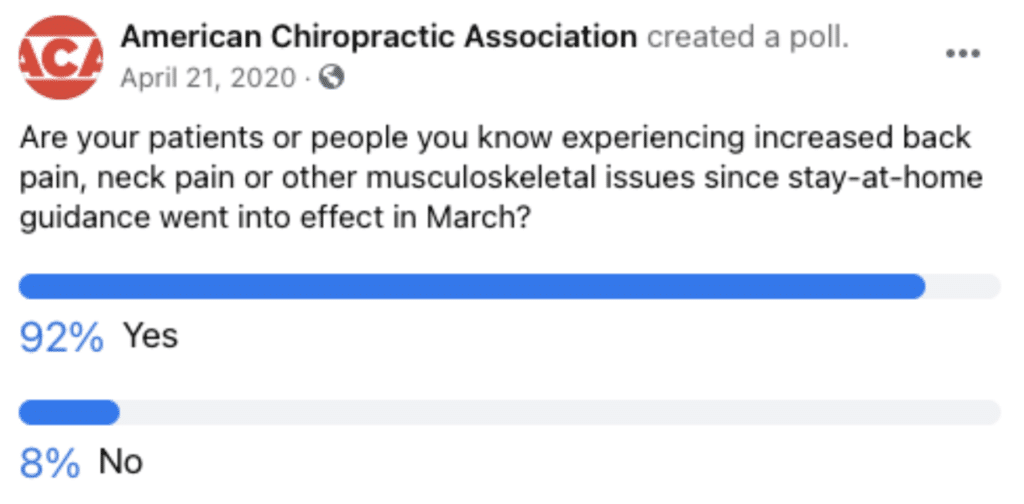Updated: December 26, 2024
A common work-related injury that many workers experience at some point during their career is a soft-tissue injury. Also known as a work-related musculoskeletal disorder (MSD), this kind of injury is common enough that around 34 percent of all missing workdays in the U.S. can be attributed to soft-tissue injuries. A third of all workers’ compensation payouts are for soft-tissue injuries.
That’s in a “normal” year.
However, 2020 was far from a normal year.
With COVID-19 keeping much of the country working from home, analysts are saying that they have seen a rise in weight gain caused by more stress and a more sedentary life. As a result, experts in environmental health and safety are saying to expect an increase in soft-tissue injury and occupational MSD workers’ compensation claims.
Pandemic weight gain contributing to rising occupational injury claims
In October 2020, a virtual event hosted by VelocityEHS called “The Short Conference” surveyed 500 attendees about how they were fairing in terms of their working conditions during the pandemic. Eighty-nine percent of those polled reported they were experiencing the same or more stress and muscular discomfort during the pandemic as they did before the pandemic started.
Furthermore, 95 percent of respondents stated that they expected this level of discomfort to continue into the next year.
Some experts suggest that weight gain might be playing a large role in this increased muscular discomfort. According to the American Psychological Association, the majority of Americans (61 percent) reported they gained weight during 2020. The average gain was between 7.8 and 29 pounds.
This amount of weight gain is the perfect conductor for soft-tissue injuries and other debilitating conditions. Nearly 40 percent of Americans have a body mass index (BMI) of between 30 and 35, which makes them more prone to conditions like arthritis of the knee.
Additionally, according to the National Health Interview Survey (NHIS), workers who are considered overweight and/or obese are at a higher chance (25 to 68 percent) of being injured at work than their average-weight co-workers.
Pandemic-induced labor shortages
Weight gain isn’t the only issue facing the pandemic workforce. Labor shortages have also had an impact. There are 2 major factors that are making the labor shortage seen across the nation that much more impactful:
- The record level of worker shortage, and
- The e-commerce boom.
In the U.S. alone, there are more than 9 million open job positions. This is a record number of available jobs in our workforce. While an e-commerce boom seems like a positive attribute, it has led to an increased demand for both warehouse workers and drivers needed to deliver packages.
Delivery drivers are at higher risk of experiencing a job-related MSD, so increases in these types of jobs have unsurprisingly led to OSHA reporting that employees for companies like Amazon experience 5.9 serious injuries for every 200,000 working hours in 2020. Nearly 40 percent of these injuries were categorized as MSDs.
But blue-collar workers were not the sole cause of an increase in MSD injuries. Office workers who traded in their ergonomic computers and desks for inadequate kitchen tables, huddled over their computer screens, have also reported an increase in lower back and neck pain.
A Facebook poll conducted by the American Chiropractic Association reported that 92 percent of chiropractors noted their patients were experiencing an increase in neck and back pain, as well as other musculoskeletal pains that can be directly traced to the shift to working remotely.
Early intervention is key to quick treatment
With such a marked increase in MSD injuries, the costs that employers could face are staggering. OSHA estimates that before the pandemic the total healthcare costs for MSDs were between $45 billion and $54 billion a year. This estimate will likely increase unless employers find a way to intervene with their employees before they get hurt or their injury becomes serious.
Even when employers are able to intervene early or catch a pre-existing injury, too often the first solution is surgery or prescription drug use. Many experts feel that this is unacceptable since the medical field has the tools available to individualize MSD diagnoses and target their treatment to ensure that recovery time is decreased.
Arizona workers’ compensation for workplace MSDs and other occupational conditions
When it comes to filing workers’ compensation claims, many people think of serious injuries or accidents that occur in the workplace as the only way an injured worker can be compensated. While it’s true that most work-related injury and accident claims are for things like motor vehicle accidents or slips and falls, occupational illnesses and disease are also valid reasons to seek compensation.
Musculoskeletal disorder (MSD), as defined by the Bureau of Labor Statistics of the Department of Labor, is “musculoskeletal system and connective tissue diseases and disorders when the event or exposure leading to the case is bodily reaction (e.g., bending, climbing, crawling, reaching, twisting), overexertion, or repetitive motion. MSDs do not include disorders caused by slips, trips, falls, or similar incidents.”
Examples of MSDs include:
- Hernias
- Sprains, strains and tears
Since every state has its own laws surrounding workers’ comp, it’s important to understand how your state may differ from your neighbor. In Arizona, the rules and guidelines state that most employers are required to carry workers’ compensation policies if they have 1 or more employees. Moreover, this coverage must be provided to employees at no charge.
Injuries that occur on the job are easy to receive compensation for. However, occupational illnesses and diseases can be a bit trickier since they develop over time and the employer (or their insurance company) may try to argue that it isn’t work-related.
Generally, a worker must meet certain criteria before they can receive benefits for an occupational disease.
According to Arizona laws, an employee experiencing an occupational illness or disease must be able to directly link the condition to their work activities. Furthermore, the origin of this condition must derive from their work.
For workers experiencing an occupational disease, there can also be no external factors that could have come from any unrelated working activities that contributed to the disease. In order to be compensated, the injured employee must be able to produce supporting evidence to the case.
Of the many occupational MSDs that employees can experience, tendonitis and carpal tunnel syndrome are among the most common for an office worker. The cause for carpal tunnel is repetitive hand motion, like typing. Common symptoms include:
- Hand weakness
- Numbness
- Pain
While it can be more difficult to obtain workers’ compensation for occupational illnesses like MSDs, you shouldn’t lose hope that you’ll be compensated. Don’t forfeit your right to medical treatment or compensation because of the difficulty.
Your best course of action is to speak with an attorney who has experience in handling workers’ compensation involving occupational diseases and work-related musculoskeletal disorders. For those living in Arizona, the attorneys at the Law Offices of Robert E. Wisniewski are standing by to help you get the workers’ comp benefits you’re entitled to.




 Back Injury at Work
Back Injury at Work Shoulder Injury at Work
Shoulder Injury at Work Work-Related Car Accidents
Work-Related Car Accidents Electrical Accidents & Injuries
Electrical Accidents & Injuries Post Traumatic Stress Disorder
Post Traumatic Stress Disorder Slip, Trip & Fall Injury
Slip, Trip & Fall Injury